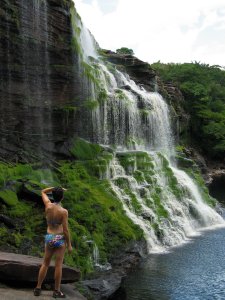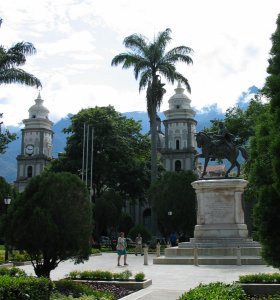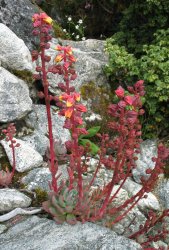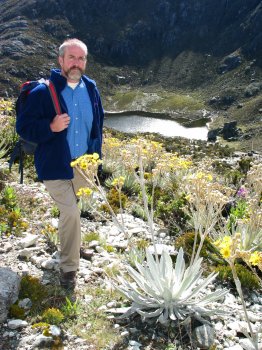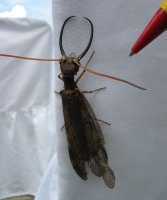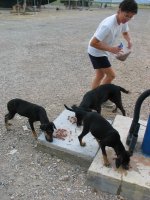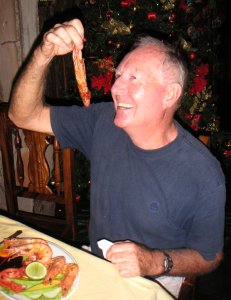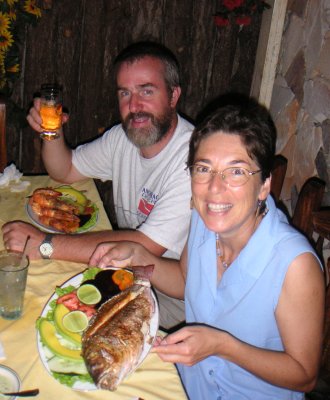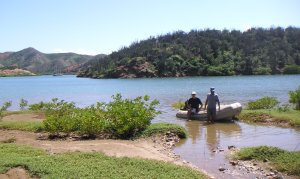 Venezuela
- Oct-Dec 2004
Venezuela
- Oct-Dec 2004
|
We arrived back in Cumaná on the 6th October to overpowering heat and humidity. After a few days acclimatising, i.e. lying in a pool of sweat, saying "Oh, it's hot...", we got on with all the maintenance work needed on the boat. Nechtan had survived the ferocious Venezuelan sun pretty well, but was still in need of some TLC, like touching up the paintwork, resealing deck seams, re-antifouling, servicing the winches, servicing the windvane, etc, etc...
|
Hibiscus. |
|
Post-thunderstorm puddles. |
Apart from the heat, we found the humidity in Venezuela quite tiring. Thankfully, most days there was a thunderstorm in the late afternoon which helped to clear the air for a few hours. And the lightning in some of those thunderstorms was spectacular! The rain accompanying these tropical thunderstorms also has to be seen to be believed - occasionally the boatyard ended up looking as though the boats were launched and floating! |
|
While we had been away in Scotland some 6-legged squatters had moved into Nechtan - cockroaches! Aargh! We had left some "cockroach hotels" onboard in anticipation of this and were glad we had, although cockies are wily critters and not all were in the traps. However we would far rather have cockies than mice, or worse still, rats! For those of you lucky enough not to have to use a cockroach hotel and who may be wondering what they are, basically they consist of some bait in the centre of a gluey pad - the cocky wanders in, and before he even gets any food, gets stuck. Yes, a lingering death, so they are cruel, but most effective.
|
A fancy cockroach hotel and its contents! |
|
Other types of cocky traps lure them in with bait which is poisoned. The cocky eats the poison and can then go away somewhere nice to die, but usually lays an egg sac beforehand - just what you don't want! PS: Cockies in the tropics come in various shapes, colours and sizes - the biggest we have seen so far are about 3 inches in length - not on the boat thankfully! ... yet!!
|
|
Entrance to Cueva del Guácharos - glad we wore boots - an umbrella would have been useful too (bird poop from above)! |
We took time out from slaving away on the boat to head inland and see the the Cueva del Guácharos (Cave of the Oil Birds). This massive cave system is home to thousands of big fruit-eating birds that echo-locate like bats and only come out at night. We have no photos of these birds because flashes disturb them, however, the pictures below show some of the limestone formations about a kilometre into the cave, where there are no birds. The cave is situated near the town of Caripe, a couple of hours inland by car from Cumaná and up in the hills, so it was lovely and cool. |
| |
|
|
|
Golfo de Cariacou, looking west. |
|
After another week or so boat work in Cumaná, we went off travelling again. This time we were going to see one of Venezuela's most famous natural wonders - Salto Angel, or Angel Falls as us gringos call it! It's the highest waterfall in the world - an uninterrupted drop of over 3000 feet, from a table-top mountain (a "tepui" in native Indian) located in the wilderness of south-eastern Venezuela. The waterfall was discovered in 1937 by a daft American barn-storming pilot called Jimmie Angel, reportedly looking for gold. He landed his plane on the plateau at the top of the falls, found he couldn't take off again and had to climb down the mountain and walk through the jungle to the nearest village - it took him and his 3 passengers 11 days to get out! (One of them was his wife - imagine the nagging he got! "I told you not to park there...What were you thinking about?...How are you going to get your plane back then?...Didn't think of that did you?......") His plane lay undisturbed for the next thirty years, until it was lifted out by military helicopter. It has been restored and is now a national monument (to male stupidity perhaps?), parked at the entrance to Ciudad Bolivar airport. |
|
|
Jimmie Angel's aeroplane. |
|
|
The Angel Falls are magnificent and it's difficult to appreciate the scale of them - that's a 3000 foot drop! |
Getting to Angel Falls is still pretty difficult. You have to fly in a small aircraft about an hour from Ciudad Bolivar to an airstrip at Canaima in the middle of nowhere. There, you can either take a three quarter-hour flight, or go by boat upriver over 2 days, lifting the boat over the rapids and sleeping in hammocks by night. We took the posh option! The flight follows the Cañon del Diablo (Devil's Canyon) until you see the waterfall plummeting down the side of Auyantepui (Mountain of the Evil God) - cheery wee place!
|
|
While in Canaima, we also got got to splash around in the lagoon and the nearby waterfalls. One of the falls, Salto El Sapo, has a path behind it where we got a free shower - very refreshing in the heat of the day!
|
|
Canaima Lagoon. |
Our boat and guide, Alex. |
|
|
Salto El Sapo.
|
|
|
We stayed in Ciudad Bolivar for another few days. It's a nice old town on the shores of the Rio Grande, a southern tributary of the Orinoco Delta, with many historic buildings associated with the wars of independence against Spain. In 1817 Simon Bolivar, or The Liberator as he is known here, master-minded the final stages of independence from this town, which was formerly called Angostura. Thousands of British mercenaries fought under him as the Napoleonic wars had just finished in Europe and they had nothing else to do. Even now, Bolivar is Venezuela's greatest hero and every town or village has a statue of him in their main square.
|
Plaza Bolivar and the Cathedral, Ciudad Bolivar. |
|
The streets of Ciudad Bolivar are colourful and steep. Intricate watch repairs are conducted at the kerb-side. |
|
The Puente de Angostura is the only bridge over the Orinoco along its entire 2140km length. |
|
After another week in Cumaná, we decided that we needed to cool off. Merida is a town in eastern Venezuela, in the Andes, and has daytime temperatures in the mid-20's. We spent two weeks there literally chilling out. |
|
Modern art? No, just chairs awaiting bottoms at an outdoor political meeting. Which reminds me.... |
|
..."Does my bum look big in this?" |
|
Spanish Lessons. |
While we were there, we took a week-long Spanish course. Our main teacher was Hercy, who has lots of patience and was great fun. Now, no more embarassing moments like the time Tom wanted a 3-pin plug (enchufe con tres polos) but asked for an "enchufe con tres pollos" (3-chicken plug!). We could still hear the ironmonger laughing and shouting "3-chicken plug!" when we were half way down the street... |
|
Plaza Bolivar, with obligatory statue of Simon Bolivar, and the Catedral Metropolitana in the background. |
Construction of the Catedral Metropolitana was started in 1800, but not completed until 1985. |
| Merida holds several world records: The highest cable car in the world, the longest cable car in the world, the second oldest bell in the world (the oldest is in Ireland apparently) and the ice cream shop with the most flavours in the world. We can honestly say that garlic ice cream is something you should try once in your life - but only once! Other flavours included smoked trout, onion, tuna and beer. For the sober customers they also had rose petal, strawberry, marie biscuit, pineapple, which were yummy, but if you want the full menu, you'll have to go there! |
The second oldest bell in the world, cast in 909 is in the middle (it was brought here by the first Spanish settlers). |
|
|
The Teleferico - longest (12.5km)and highest (4765m) cable car in the world. |
|
|
One day, we took the Teleferico up to 4000m and then walked over to a village called Los Nevados at around 2700m. The first hour was uphill to a pass, then five hours mainly downhill through some spectacular scenery with thousands of flowering plants. |
|
|
The start of our walk, looking up at Pico Bolivar, Venezuela's highest peak at 5007m. |
|
|
Bonny plants (which we struggle to grow back home in Scotland) abound here. |
|
|
Many of the plants are well adapted to withstand the scorching sun by day and freezing temperatures at night - this daisy has leaves covered with fine hairs for protection. |
|
The destination - Los Nevados. |
|
Breakfast the next morning was delicious - eggs, arepas, cheese, jam, fresh juice and coffee. |
|
|
The village square and church in Los Nevados. |
|
|
Los Nevados is exactly how you would picture an Andean village to be - old buildings clinging to the hillside, steep, roughly cobbled streets, no glass in the windows, no heating in the houses other than that generated by cooking, and horses and donkeys used everyday. Thankfully, in order not to discourage the tourists, there is hot water in the showers! We spent a night in Los Nevados and returned to Merida the next day by jeep. The road was little more than a track cut into the mountainside in places and very rough, but again the views were awesome. There were some spectacularly dangerous sections with almost vertical cliffs above and below the track, with landslides also both above and below! - too dangerous even to stop the jeep for a photo. Our driver was kind enough to point out the section of road that gave way under his friend two months ago, complete with hand actions of the jeep tumbling down the mountainside! |
|
The view from our guesthouse in Los Nevados was spectacular (dinner,bed & breakfast for US$10 each!) . |
|
The jeep ride back to Merida took 6 hours. |
|
|
Howkin' tatties. |
|
|
On our last day in Merida, we both went for tandem flights on paragliders. Tom had tried hang-gliding more than twenty years ago and loved the feeling of "being able to fly". So these new-fangled flying machines sounded like fun ... and they were. We took off from the top of a hill called Tierre Negro at 1600m and landed at Los Gonzales below at just 600m. The flights lasted about half an hour and all we had to do was sit there while the pilot behind us steered (they don't let you fly solo without lessons apparently!). It was great. |
|
Jorge and Tom flying. |
José and Sue flying. |
|
Before we knew it, it was December and we'd been in Venezuela for two months. Although it wasn't in the plan, we were glad we'd spent so much time here as it is a great place as well as one of the least expensive places in the Caribbean. The wildlife and scenery are stunning and the people are the friendliest we've met since Ireland. They have other things in common with the Irish - like a relaxed attitude to time. In fact, to mis-quote author Pete McCarthy, they make the Irish look like a nation of Bavarian punctuality inspectors! We made many friends here especially Frank and Tadilinka, two English teachers who gave us a tour of Cumaná, taught us Spanish and showed us great hospitality and friendship. Also, Yali, who helped us when we were looking lost at the hospital (Sue had had the runs for 3 weeks) and took us home for some fantastic typical Venezuelan meals. But just about everyone we met was happy to say "hola" and smile or pass a few minutes asking where we're from and what we think of Venezuela. |
|
Tadi showed Sue how to make arepas (corn pancakes). |
Vladimir (Frank's brother), Tadi and Frank sampling some of Scotland's best. |
|
Joana, Sue, Yali and Danni. |
Joana preparing lunch - Sopa de Pescado and arepas. |
|
Sue checks the English home-work of Adriane and Patricia, two schoolgirls who were just passing by. |
Frank, his Gran, Aunt and Cousin plus Tadi and Tom. |
|
Tadi, Sue and Frank at the Castillo de San Antonio de la Eminencia, overlooking Cumaná. |
|
This vendor does the best freshly squeezed orange juice in Cumaná! |
|
|
The Iglesia Santa Ines and the western side of Cumaná. |
|
|
The wildlife in Venezuela is friendly too: |
|
Joachim the pet parrot at Canaima (Sue is covering her buttons as he likes to crack them like nuts). |
|
This beastie in Merida was too big to hold in my hand! |
|
A friendly Burro at Miraflores. |
|
Capochin monkey at Canaima. |
|
A wee terrapin ... |
|
... and a wee lizard. |
|
|
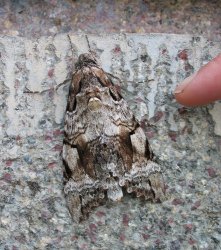 |
A not so wee moth which was well camouflaged on the granite wall of the Catedral in Merida.
|
|
|
Sue's dogs (Scratcher, Blackie and Isla). |
Then, there were the boatyard dogs. Sue adopted these while we were at Navimca and they were definitely fatter and less flea-ridden by the time we left. They followed us everywhere, so that Sue became known as La Senora del Perros (the dog lady).
|
|
Other memories of the Navimca boatyard include the many wonderful people we met who work there, or who, like us, are just passing through. Sadly we don't have pictures of everyone! |
|
Marlyse, who speaks several languages, provides invaluable help to all the boaties - a great asset to the boatyard. |
|
Mike of "Gypsy Blue", Peter and Inge of "Antares" and Liam of "Banshee" at a super little fish restaurant. |
|
Odalys works at Navimca reception and is always smiling and helpful! |
|
Stop playing with your food, Liam! |
|
Mmmm, yummy! |
|
There was always enough water for clothes washing ... always enough clothes too! |
|
But the signs were everywhere that Christmas was approaching and we should be heading west. So, time to put the boat back in the water and start moving again. Before leaving Cumaná, we stocked up on beer (15 pence a can) and diesel (less than 2 pence a litre!), two essentials of a cruising lifestyle. We also topped up the medical kit with a couple of extra packets of medicines (principally diarrhoea ones!). Many of the antibiotics which are expensive and for which we require a prescription back home are extremely cheap and available over the counter in Venezuela, e.g. a pack of Amoxicillin for £2 and Ciprofloxacin for £3.
|
Signs of Christmas approaching at Cumaná market. |
|
|
Ready to leave. The Araya Peninsula is in the distance. |
|
|
First stop after leaving Cumaná was the beautiful natural harbour of Laguna Grande on the southern side of the Araya Peninsula. It is totally deserted apart from a fishing camp in one corner and is very peaceful - quite a change from the constant noise of Cumaná. It felt great to be back in the water again.
|
|
|
The picture on the left shows our home-made nesting dinghy, pulled into a space in the mangroves. We use this dinghy when the shore is too rough for the inflatable. It rows like a dream and separates into two halves, one of which fits inside the other, for storing on deck. |
|
Scenes from Laguna Grande. |
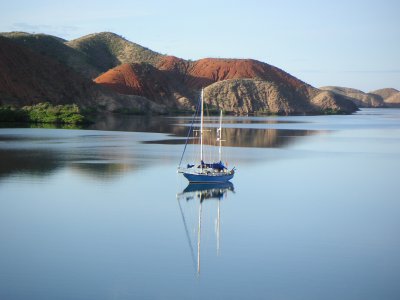 |
|
|
|
Mike and Liam larking about in the shallows. |
|
Next came an overnight sail to the island of Tortuga, low-lying with beatiful white sandy beaches. We stayed there for a couple of nights, swimming and relaxing. |
|
Nechtan at anchor. |
The fishing shacks on Tortuga have paths edged with conch shells.
Venezuela has a few problems with security (armed robberies occur both on land and at sea), but if you accept the slight risk then it really is a fascinating country to visit, with a warm, welcoming people. We left Venezuela on 19th December, headed for the island of Bonaire, 200 nautical miles to the northeast. |
